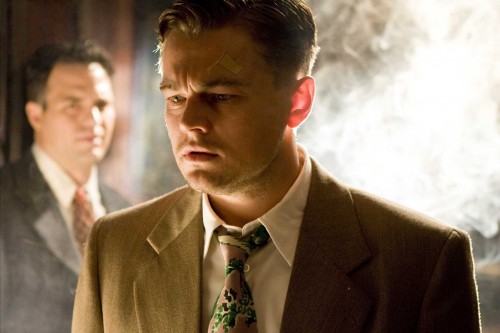Shutter Island
The Grand Marshal of a Ghost Parade

Starring: Leonardo DiCaprio, Mark Ruffalo
By Robert Patrick
“Shutter Island” is oozing with gloom and anxiety. Martin Scorsese knows better than anyone how to craft mood, slip it into every crack and crevice, slather it over every frame with artisan care. The shadows of doubt and madness have certainly fallen upon, if not entirely swallowed, an asylum hosted by an island off the coast of Boston in 1954; peculiar events begin to transpire at a gothic shelter, especially when a dangerous patient vanishes from her cell, leaving all authority figures on the island in complete confusion to her whereabouts. Enter U.S. marshal Teddy Daniels (Leonardo DiCaprio) and his nondescript, good-guy partner Chuck Aule (Mark Ruffalo), whom enter the archaic premises of the decayed facility to find answers.
The two men, surrounded by wailing inmates and iron-jawed prison guards, are out of place on an island stoked by foreign concepts and makeshift laws. And though the two outsiders attempt to use diplomatic reasoning to solve this suspicious vanishing, they end up in a sort of garish entanglement with themselves and the detached, gnarled body of land that they are on.
Teddy is perfect chum to be thrown at the intangible properties of Shutter Island; the marshal is mentally wounded, bleeding, unable to emotionally wrap up traumatic wounds from his wartime experiences in the European theater. DiCaprio is great at exhuming visceral pain, pinning it to his face, and making vulnerability look palpable instead of contrived. Mark Ruffalo, on the other hand, slinks around in the movie, looking passively, as he congenially plays “good cop” to DiCaprio’s “bad cop” routine. Ruffalo’s character reminds me of a more tepid version of David Toschi, a detective that he portrayed in David Fincher’s “Zodiac.”
“Shutter Island” isn’t as kinetic or buoyantly clever as Scorsese’s masterworks (how deistic sounding), but the pulpy pacing and syrupy narrative is, when looking at the axis of the film, indicative of the story’s theme of doom and isolation. There are cavalcades of serpentine visuals, spinning like a hallucinatory cat’s cradle, throughout the picture; I can remember thinking of, if only briefly, the minimalist fear of “The Innocence.” Other times, I thought about the wispily surreal images employed by Andrei Tarkovsky. There is a lot of stunning things going on here that, upon finishing the film, require another viewing; in fact, I’d go as far as to say that a double feature of “Shutter Island” would do the narrative proper justice. That isn’t to say that Scorsese made a disjointed or inscrutable film – I only believe that there is much to be admired.
The score of “Shutter Island” is really, to use an overly used sports term, the twelfth man. A booming, cacophonous dread flushes over the theater when Krzysztof Penderecki’s “Symphony Number 3” loudly uncoils over the speakers. Unabridged menace plants its feet down firmly within the opening seconds, never letting its weight shift once during the running time.
The missing patient at Shutter Island is a pandora’s box of wicked things, so scarily shrouded, in Scorsese’s newest opus. Ashes of formality and civility drift off to sea in “Shutter Island,” leaving only a eerie wake for the now fleeting idea of sanity. Teddy and Chuck, in wading through the allegedly avant-garde practices at the asylum, are tried in a way that requires wincing. Man, these two do not get breaks.
The bulk of the film is beautiful, but it lacks, of all things, that Scorsese thumb print. I felt like it could’ve been made by (yes, second time I’m bringing him up) David Fincher or even David Lynch or David-somebody. The lull of bloody poeticism and tainted grace that are so archetypical of Scorsese are vacant here, but the greatness remains in flashes.
3.5/5
